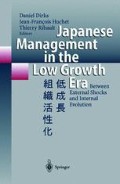Abstract
Japanese industrial keiretsu (groups of firms with a strong interdependence in terms of turnover) which contributed to the Japanese economic performance over the past decades, have been facing internal as well as external constraints since the 1980s. The rise of the yen after 1985, the liberalization of Asian markets and the high growth pace in this region have all provoked an increase of foreign direct investment and a relocation of firms. This in turn has affected the volume of orders to suppliers in Japan, leading them to take measures to adapt to the new situation of globalized purchasing networks. An international division of labour in Asia is taking place, away from the former concentration on national structures, resulting in a structural evolution of the Japanese purchasing system and therefore the keiretsu.Based on these present changes, the constitution of Nippo-Asian keiretsu is proposed as a possible scenario for the future.
Access this chapter
Tax calculation will be finalised at checkout
Purchases are for personal use only
Preview
Unable to display preview. Download preview PDF.
References
Abo, T. (1995): A Comparison of Japanese ‘Hybrid Factories’ in the U.S., Europe and Asia. In: Management International Review 35, Special Issue 1/95, pp. 79–93.
Aoki, M. (1988): Information, Incentives, and Bargaining in the Japanese Economy.Cambridge /Mass.: Cambridge University Press.
ChūShō KigyōChō (1989,1993,1997): Chūshō kigyō hakusho (White Paper on Small and Medium Sized Firms). Tōkyō: Chūshō Kigyōchō.
Dore, R. (1987): Taking Japan Seriously.Stanford: Stanford University Press.
Fourin (1995): 1995 Nihon jidōsha buhin sangyō no Ajia jigyō tenkai: chōtatsu kōzō o kaeru Ajia de no jigyō kakudai [The Shift to Asia of Car and Car-parts Industry: Increased Activities in Asia and the Changes in the Purchasing Structure]. Nagoya: Fourin Kabushiki Gaisha.
Fukuda, R. (1996): Asean ikinai-gai no kokusai bungyō taisei Bbc/Aico/Cept [The International Division of Labour through the Bbc/Aico/Cept System in and outside the Asean Area], unpublished manuscript.
Fujimoto, T. (1994): Nōryoku chikuseki no purōsesu to kajō tekiō: jidōsha sekkei no kesu [The Process of Knowledge Build-up and Excess Capability: The Case of Design in the Car Industry]. Discussion Papers Series n° 94-J-18 Faculty of Economics. Tōkyō: University of Tokyo.
Harada, Y. (1995): Ajia to no kokusai bungyō no eikyō [Impact of the International Division of Labour with Asia]. In: Tbr Keiei Kankyō Rebyū, n°2, pp. 9–12.
Kageyama, K. (1996): Ajia ni okeru jidōsha sangyō no hatten: Toyota shisutemu o chūshin to suru kokusaiteki saihensei [The Development of the Car Industry in Asia: International Restructuring Centred on the Toyota Production System]. In: Seikai Keizai Hyōron 40, n° 1, January, pp. 59–68.
Lecler, Y. (1993): Partenariat industriel: la référence Japonaise [Industrial Partnership, Japan as a Reference]. Limonest: l’interdisciplinaire, collection technologies.
Lecler, Y. (1995): Délocalisations industrielles et restructuration du système de sous-traitance [Industrial Relocations and Restructuring of the Subcontracting System]. In: Ebisu n° 10, July/September (Tōkyō: Maison Franco-Japonaise), pp. 7–32.
Lecler, Y. (1997): Libéralisation des investissements étrangers: la surenchère entre les pays de r Asean et 1a Chine [Liberalization of Foreign Direct Investment: the Competition between China and Asean]. In: Informations et commentaires n° 98, April/June, pp. 5–11.
Nishiguchi, T. (1994): Strategic Industrial Sourcing: The Japanese Advantage.Oxford: Oxford University Press.
ŌSaka ShōKō Kaigisho SangyōBu (1993): Zaihan seizōgyō no kaigai shinshutsu dōkō [Foreign Penetration of Osaka’s Manufacturing Industry]. Ōsaka: Ōsaka Shōkō Kaigisho.
Osaka ShōKō Kaigisho (1994): Zaihan sokeizai sangyō no jittai ni kansuru chōsa [Results of Surveys on the Situation of the Primary Metal Processing Industries in the Ōsaka Region]. Ōsaka Shōkō Kaigisho.
Sako, M. (1992): Prices, Quality and Trust. Inter-firm Relations in Britain and Japan.Oxford: Oxford University Press.
Sato, Y. (1992): Kokusaika no shinten to shitauke bungyō kōzō: — “gaikan”: rekishi no naka de henbō suru Nihonkei shitauke bungyō seisan shisutemu [The Growth of Internationalization and the Structure of the Division of Labour in Subcontracting Activities — “A General Point of View”: Lectures in History on the Changes in the Production System of the Division of Labour in the Subcontracting Activities in Japan]. In: Shōkō Kinyū 42, n° 6: pp. 4–21.
TsūShō SangyōChō (1994): Tsūshō hakusho [White Paper on Trade]. Tōkyō: Tsūshō Sangyōchō.
TuRcq, D. (1992): L’inévitable partenaire Japonais: repères dans un dédale [The Inevitable Japanese Partner: Hints in a Daedalus]. Paris: Fayard.
Watanabe, Y. (1996): Shitauke chūshō kigyō to keiretsu, juchū seisangata chūshō kigyō no juzokuteki seichō kara jiritsuteki seichō e no michi [Subcontracting Smes and Keiretsu, from Growth Based on Dependence to Growth based on Independence]. In: Bijinesu Rebyū 43, n°2, pp. 14–36.
Editor information
Editors and Affiliations
Rights and permissions
Copyright information
© 1999 Springer-Verlag Berlin Heidelberg
About this paper
Cite this paper
Lecler, Y. (1999). Recession and Globalization: What Future for Japanese Industrial Keiretsu? . In: Dirks, D., Huchet, JF., Ribault, T. (eds) Japanese Management in the Low Growth Era. Springer, Berlin, Heidelberg. https://doi.org/10.1007/978-3-642-58257-8_13
Download citation
DOI: https://doi.org/10.1007/978-3-642-58257-8_13
Publisher Name: Springer, Berlin, Heidelberg
Print ISBN: 978-3-642-63518-2
Online ISBN: 978-3-642-58257-8
eBook Packages: Springer Book Archive

